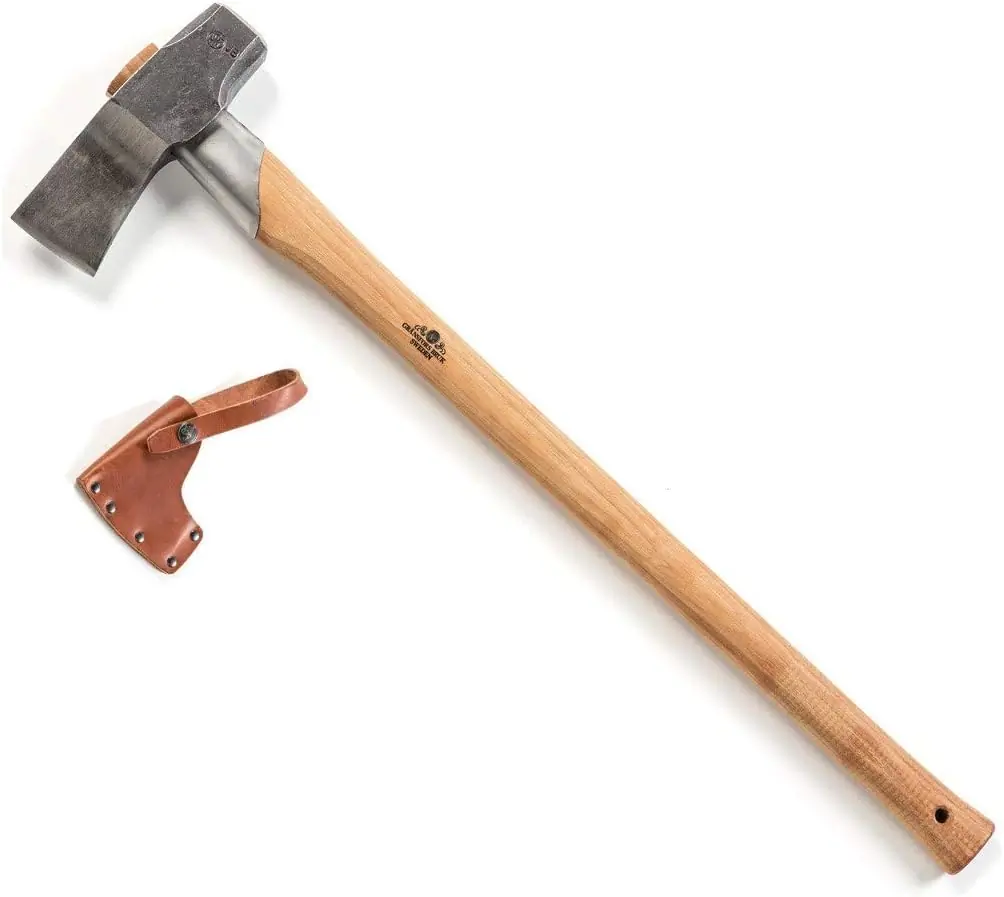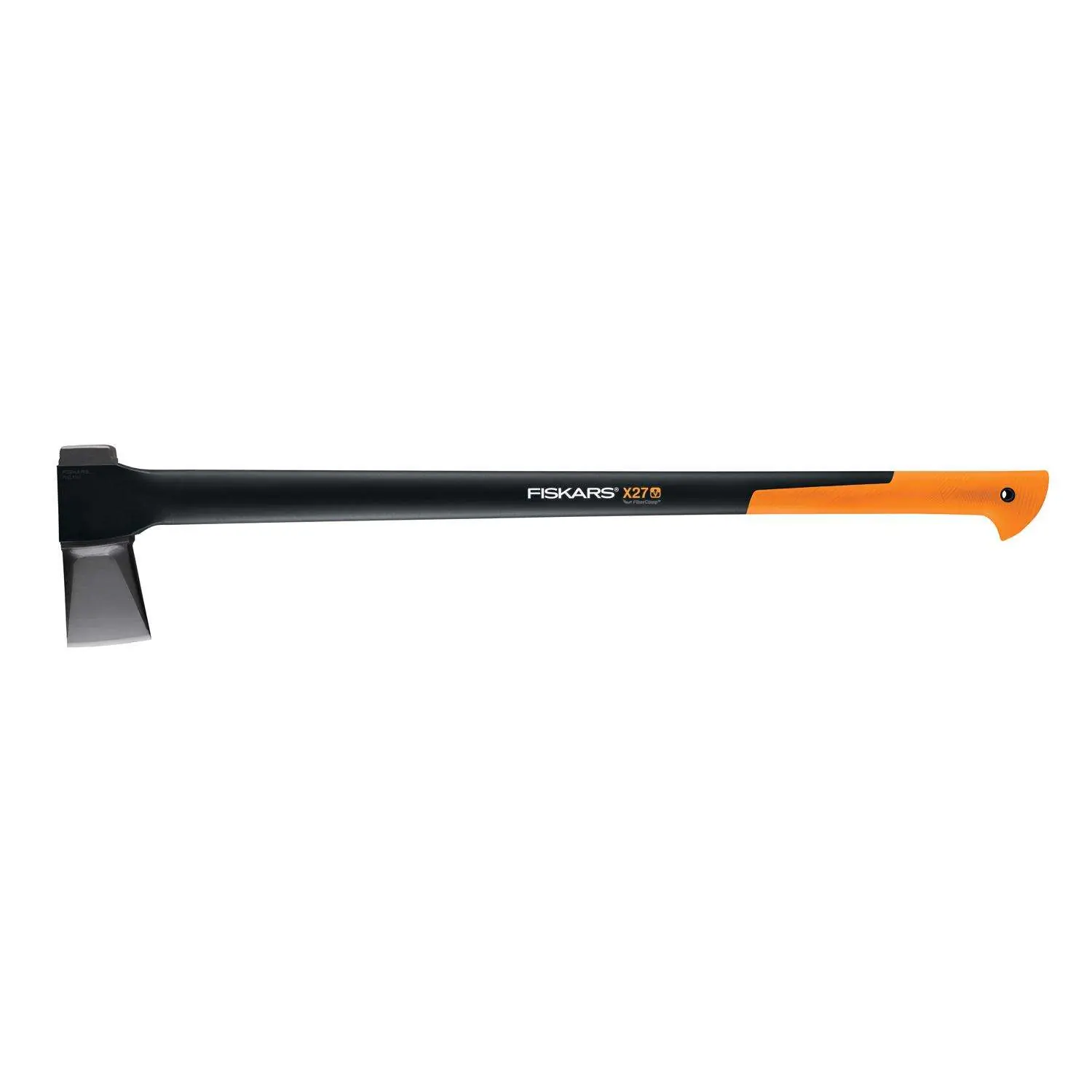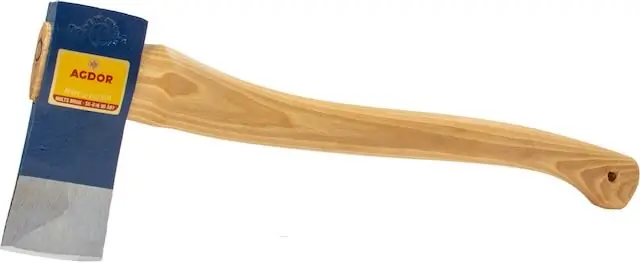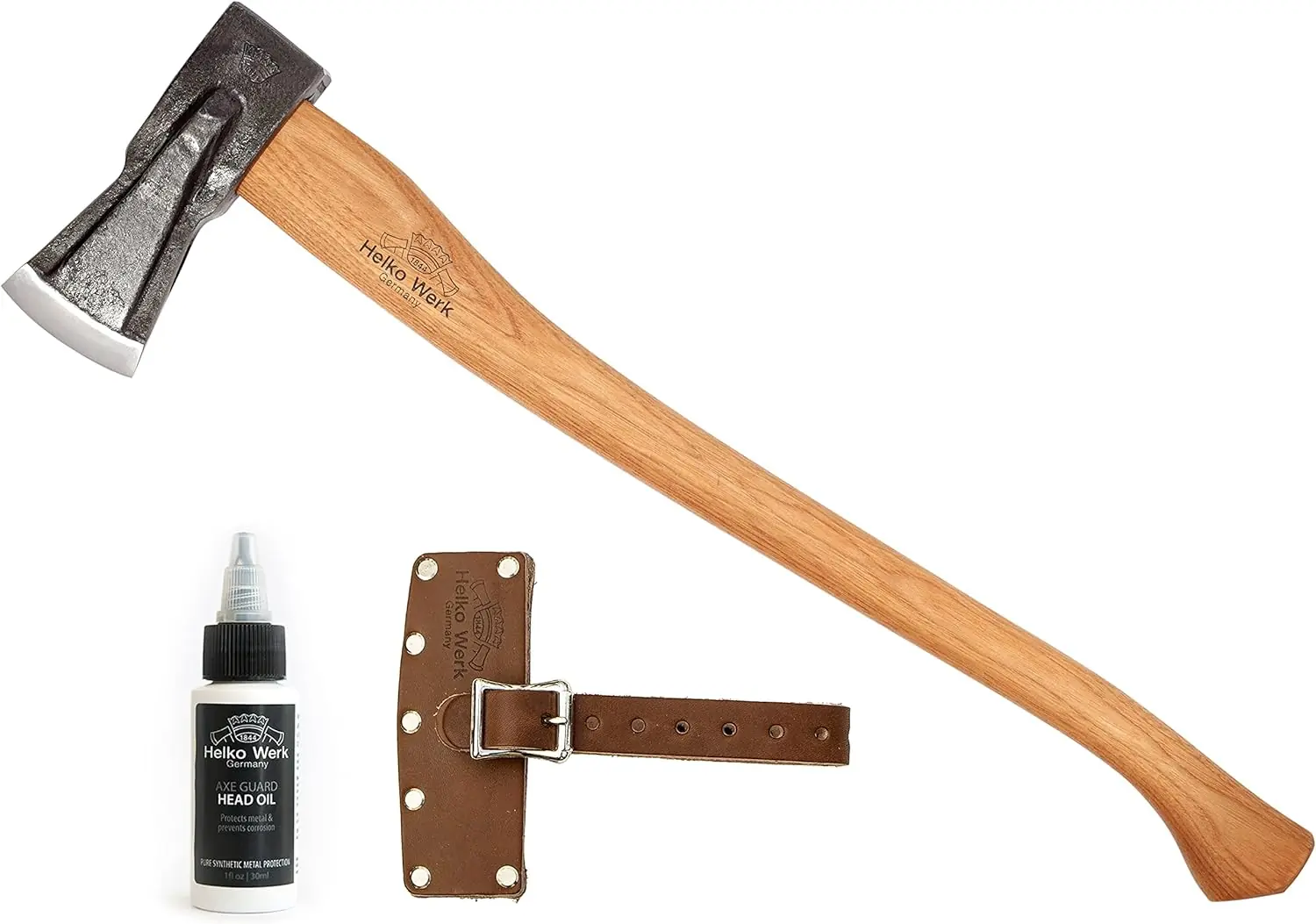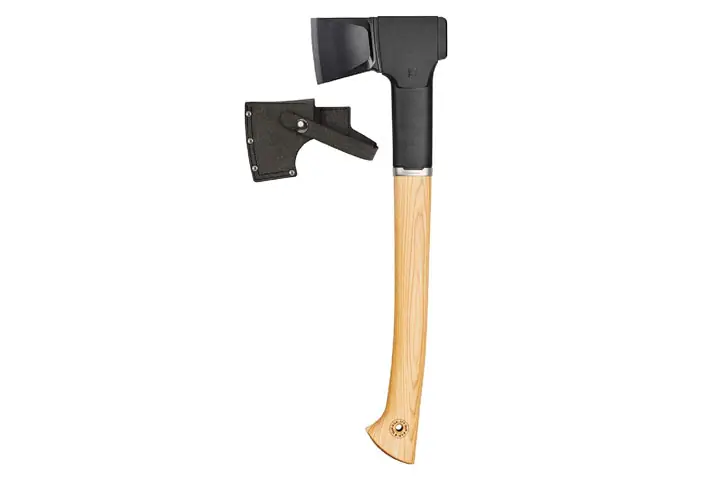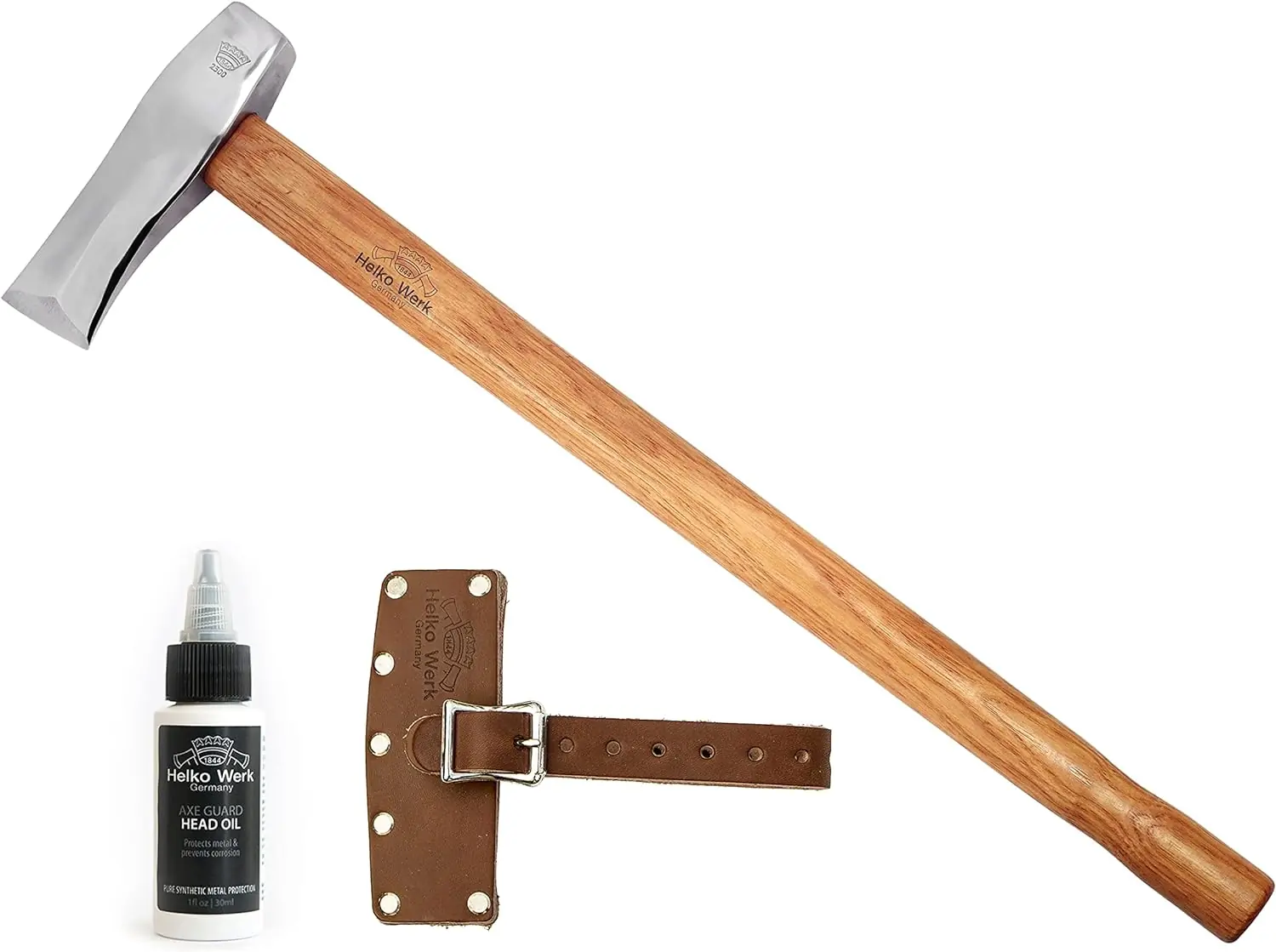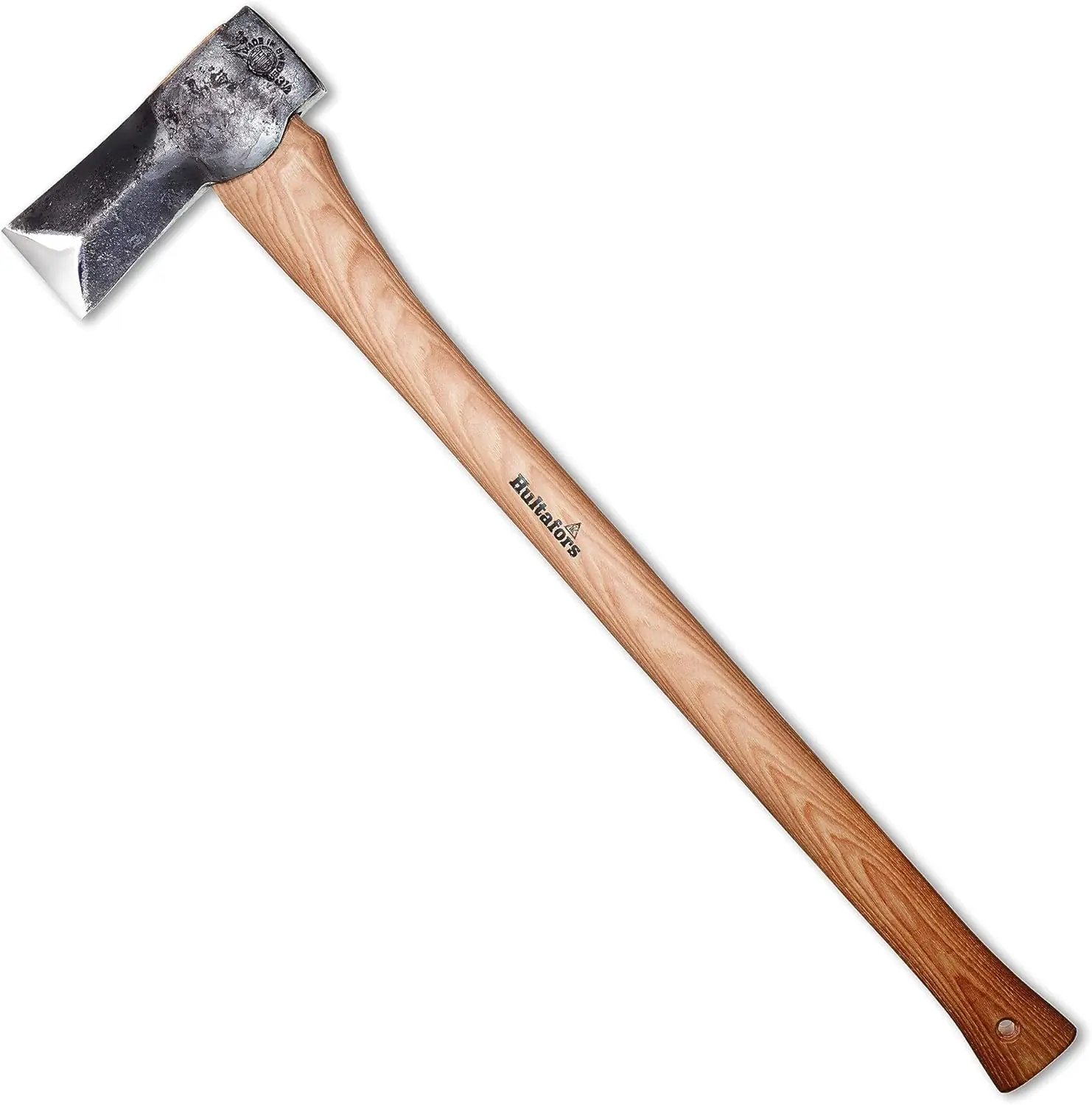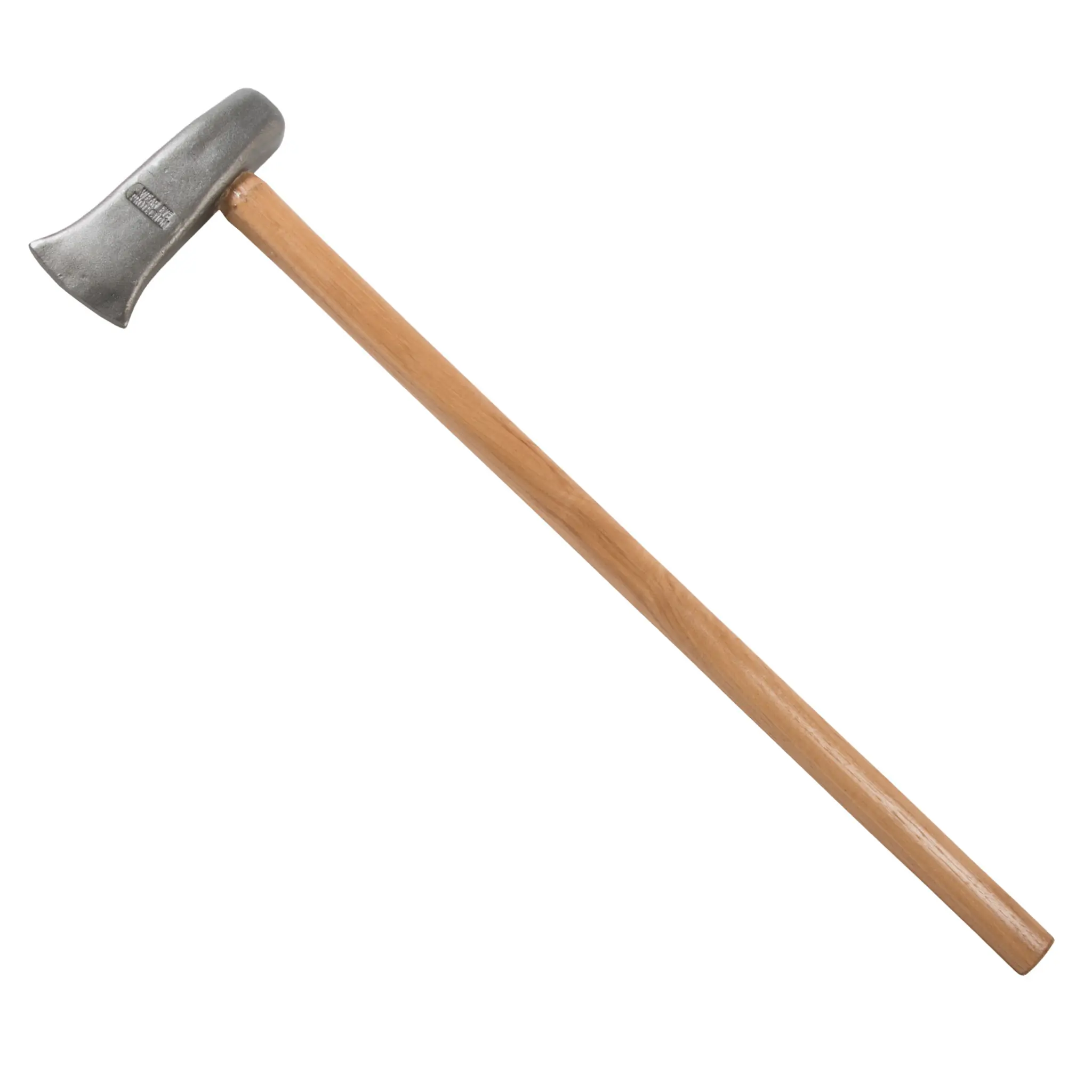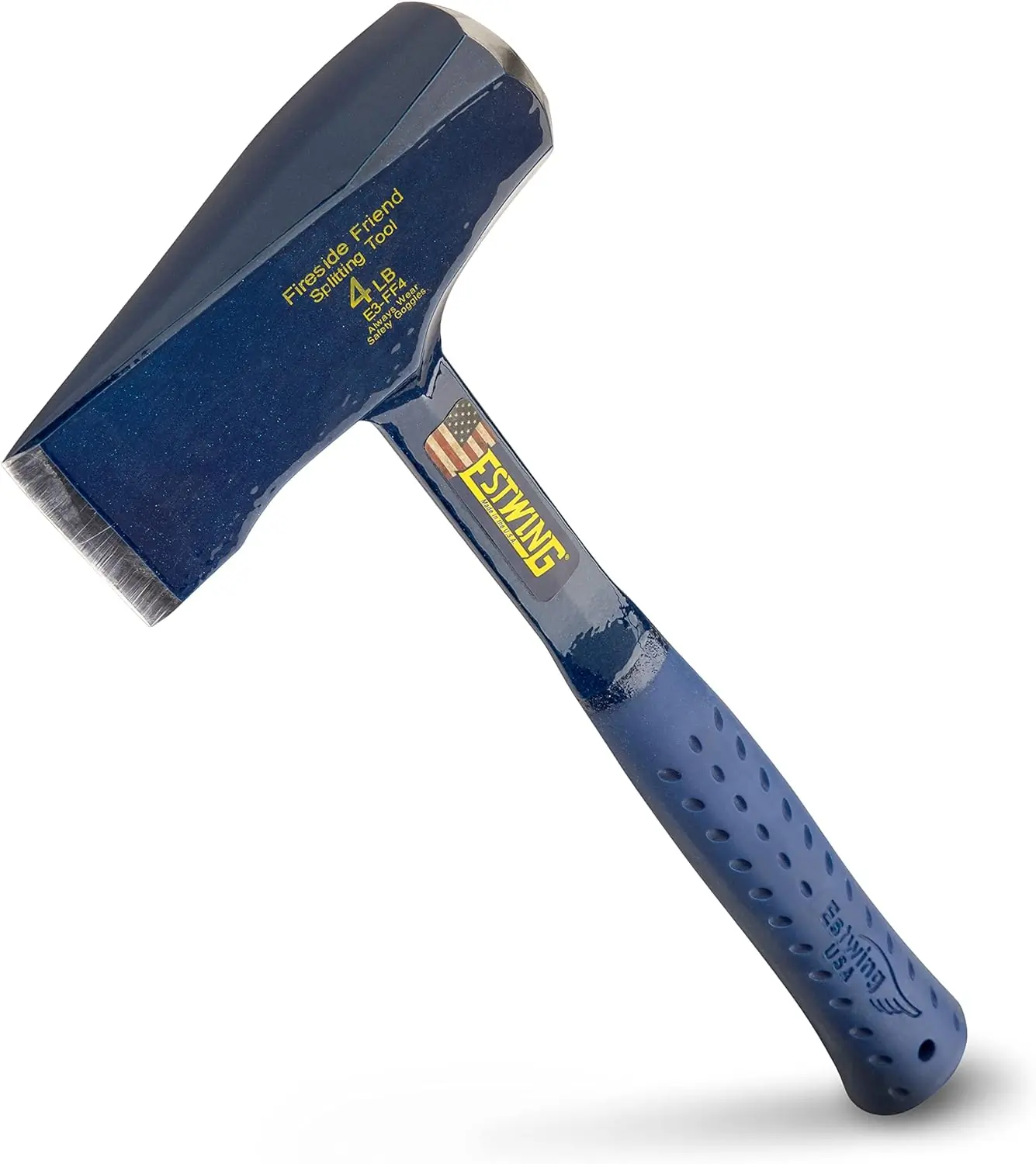We spent the last two summers hauling, drying, splitting, and stacking nearly four cords of firewood. During this process, we tested 11 of the best axes for splitting wood side-by-side, to help you find the right tool for your next project.
With our testing based in the forests around Lake Tahoe, we faced freshly cut pine and fir rounds ranging from 14 to over 30 inches in diameter that gave us all the twisty, sappy grain structures and dense, chunky knots we could handle. While we were lucky enough to split some rounds with one or two easy strikes, other more heinous pieces took up to 20 or 30 well-placed blows for the timber to finally relent.
We purchased and tested a variety of the top splitting axes from around the world, from hand-forged heirloom-quality pieces of Scandinavian descent, to more modern designs with higher-tech materials. We used each splitting axe over a dozen times to get an advanced impression of each tool’s build quality, balance and feel, and wood-splitting performance. For the best of the best, check out the Gransfors Bruk Splitting Maul. If you’re new to wood splitting and want a capable budget pick, we recommend the Fiskars X27 Super Splitting Axe.
We’ve also compiled a list of critical measurements and specifications to help you find the best splitting axe for your personal size, strength, design preferences, and wood-splitting needs.
Editor’s Note: We updated this Guide on November 13, 2024, adding two smaller splitting axes ideal for lighter-duty one-handed use, the Hults Bruk Agdor 20 and the Fiskars Norden N12.
The Best Axes for Splitting Wood of 2024
Gransfors Bruk Splitting Maul
- Head Weight: 5.5 lbs.
- Total Weight: 7.2 lbs.
- Handle Length: 31.5 in.
- Handle Material: Hickory Wood
- Country of Origin: Sweden
Pros
- Well-balanced feel for optimum blend of power and efficiency
- Hand-forged head has ideal blade shape for splitting wood
- Handle includes protective steel collar below the head
- Aesthetically pleasing design
Cons
- Expensive
Fiskars X27 Super Splitting Axe
- Head Weight: 4.0 lbs.
- Total Weight: 5.7 lbs.
- Handle Length: 36.0 in.
- Handle Material: Composite
- Country of Origin: Finland
Pros
- Long, lightweight handle is easy to swing
- Composite handle material helps absorb shock
- Shape of the head and blade are effective for splitting
- Affordable price tag
Cons
- Longer handle may not be ideal for everyone
- Lighter weight is less powerful than heavier axes
- Composite handle cannot be replaced if it breaks (though it is very strong)
Hults Bruk Agdor 20 Splitting Axe
- Head Weight: 2.0 lbs.
- Total Weight: 2.9 lbs.
- Handle Length: 20.0 in.
- Handle Material: Hickory Wood
- Country of Origin: Sweden
Pros
- Hand-forged head has an efficient shape for splitting
- Cured hickory handle has a nice balanced feel
- Includes a thick leather blade sheath
- Light enough to be use one- or two-handed
Cons
- Smaller size limits use to smaller logs and kindling
- Has a more rustic fit and finish compared to some other models
Helko Werk Traditional Spaltaxt
- Head Weight: 4.5 lbs.
- Total Weight: 5.8 lbs.
- Handle Length: 28.0 in.
- Handle Material: Hickory Wood
- Country of Origin: Germany
Pros
- Strong and efficient wedge-shaped head
- Ergonomic handle provides great comfort and control
- Shorter and lighter design reduces fatigue
- Beautiful design and construction
Cons
- Fairly expensive
- Not as powerful as longer and heavier splitters
Husqvarna Composite Splitting Axe S2800
- Head Weight: 5.0 lbs.
- Total Weight: 6.2 lbs.
- Handle Length: 28.0 in.
- Handle Material: Composite
- Country of Origin: Sweden
Pros
- Shorter handle provides more control for precise strikes
- Longer blade edge is effective for splitting smaller logs
- Comfortable weight and size for different people
- Includes protective collar below head
- Reasonable price
Cons
- Shorter length and lighter weight are not as effective for splitting extra large rounds
- Longer, narrower blade edge can get stuck easier in larger logs or rounds
Gedore Ochsenkopf Spalt-Fix Axe
- Head Weight: 5.5 lbs.
- Total Weight: 8.2 lbs.
- Handle Length: 31.5 in.
- Handle Material: Hickory Wood
- Country of Origin: Germany
Pros
- Heavy, wedge-shaped head powers through tough logs or rounds
- Rotband-Plus head-to-handle connection system is strong and secure
- Includes protective sleeve on handle below head
- Comfortable handle shape
Cons
- Heavier overall weight may be harder to control for some users
- Narrow blade edge can get stuck in softer or extra large rounds
Fiskars Norden N12 Splitting Axe
- Head Weight: Not listed
- Total Weight: 2.8 lbs.
- Handle Length: 19.0 in.
- Handle Material: Hickory Wood
- Country of Origin: Finland
Pros
- Very clean look and finish
- Hickory wood handle with FiberComp overstrike collar
- Over-molded axe head inspires confidence
- Ergonomic handle shape
- Can be used one- or two-handed
Cons
- Unique blade and shaft joint means handle is not replaceable
- Black finish wears off with use
- Limited to light-duty use with small logs or kindling
- Head Weight: 5.5 lbs.
- Total Weight: 7.2 lbs.
- Handle Length: 31.0 in.
- Handle Material: Hickory Wood
- Country of Origin: Germany
Pros
- Beautiful aesthetics with polished steel head
- Traditional Swedish wedge-style head is effective for splitting
- Heavier weight helps power through logs
Cons
- Feels heavier than the specs indicate
- Larger handle girth is harder to control for smaller or average-sized hands
- Fairly pricey
- Head Weight: 3.3 lbs.
- Total Weight: 4.5 lbs.
- Handle Length: 30.0 in.
- Handle Material: Hickory Wood
- Country of Origin: Sweden
Pros
- Beautiful hand-forged head
- Lightweight design allows fast swing velocity
- Company legacy goes back to 1697
Cons
- Lighter head and narrower blade struggle with large logs or rounds
- Shorter blade edge can lead to overstrikes
- Somewhat expensive
- Head Weight: 6.0 lbs.
- Total Weight: 7.3 lbs.
- Handle Length: 36.0 in.
- Handle Material: Hickory Wood
- Country of Origin: USA
Pros
- Large, heavy head helps power through tough logs
- Affordable price
Cons
- Narrow, straight handle is not as ergonomic as other designs
- Doesn't feel as well-balanced or refined as other models
- Heavier weight is can be harder to control during extended splitting sessions
- Head Weight: 4.0 lbs.
- Total Weight: 4.1 lbs.
- Handle Length: 14.0 in.
- Handle Material: Steel
- Country of Origin: USA
Pros
- Wedged head shape is effective for splitting smaller logs
- Doubles as a handheld sledge hammer
- Comfortable handle grip
Cons
- Heavy head with short handle feels awkward for splitting
- Still requires a full swing to be effective
- Short handle puts user closer to impact zone
Best Splitting Axes Comparison Chart
| Winter Jacket | Price | Head Weight | Total Weight | Handle Length | Handle Material |
|---|---|---|---|---|---|
| Gransfors Bruk Splitting Maul | $255 | 5.5 lbs. | 7.2 lbs. | 31.5 in. | Hickory Wood |
| Fiskars X27 Super Splitting Axe | $70 | 4.0 lbs. | 5.7 lbs. | 36.0 in. | Composite |
| Hults Bruk Agdor 20 Splitting Axe | $134 | 2.0 lbs. | 2.8 lbs. | 20.0 in. | Hickory Wood |
| Helko Werk Traditional Spaltaxt | $180 | 4.5 lbs. | 5.8 lbs. | 28.0 in. | Hickory Wood |
| Husqvarna Splitting Axe 2800 | $100 | 5.0 lbs. | 6.2 lbs. | 28.0 in. | Composite |
| Gedore Ochsenkopf Spalt-Fix Axe | $130 | 5.5 lbs. | 8.2 lbs. | 31.5 in. | Hickory Wood |
| Fiskars Norden N12 Splitting Axe | $120 | Not listed | 2.8 lbs. | 19.0 in. | Hickory Wood |
| Helko Werk Classic Nordic Splitting Axe | $190 | 5.5 lbs. | 7.2 lbs. | 31.0 in. | Hickory Wood |
| Hultafors Hult Splitting Axe | $200 | 3.3 lbs. | 4.5 lbs. | 30.0 in. | Hickory Wood |
| Council Tool 6-lb Sledge-Eye Maul | $59 | 6.0 lbs. | 7.3 lbs. | 36.0 in. | Hickory Wood |
| Estwing Fireside Friend Splitting Tool | $35 | 4.0 lbs. | 4.1 lbs. | 14.0 in. | Steel |
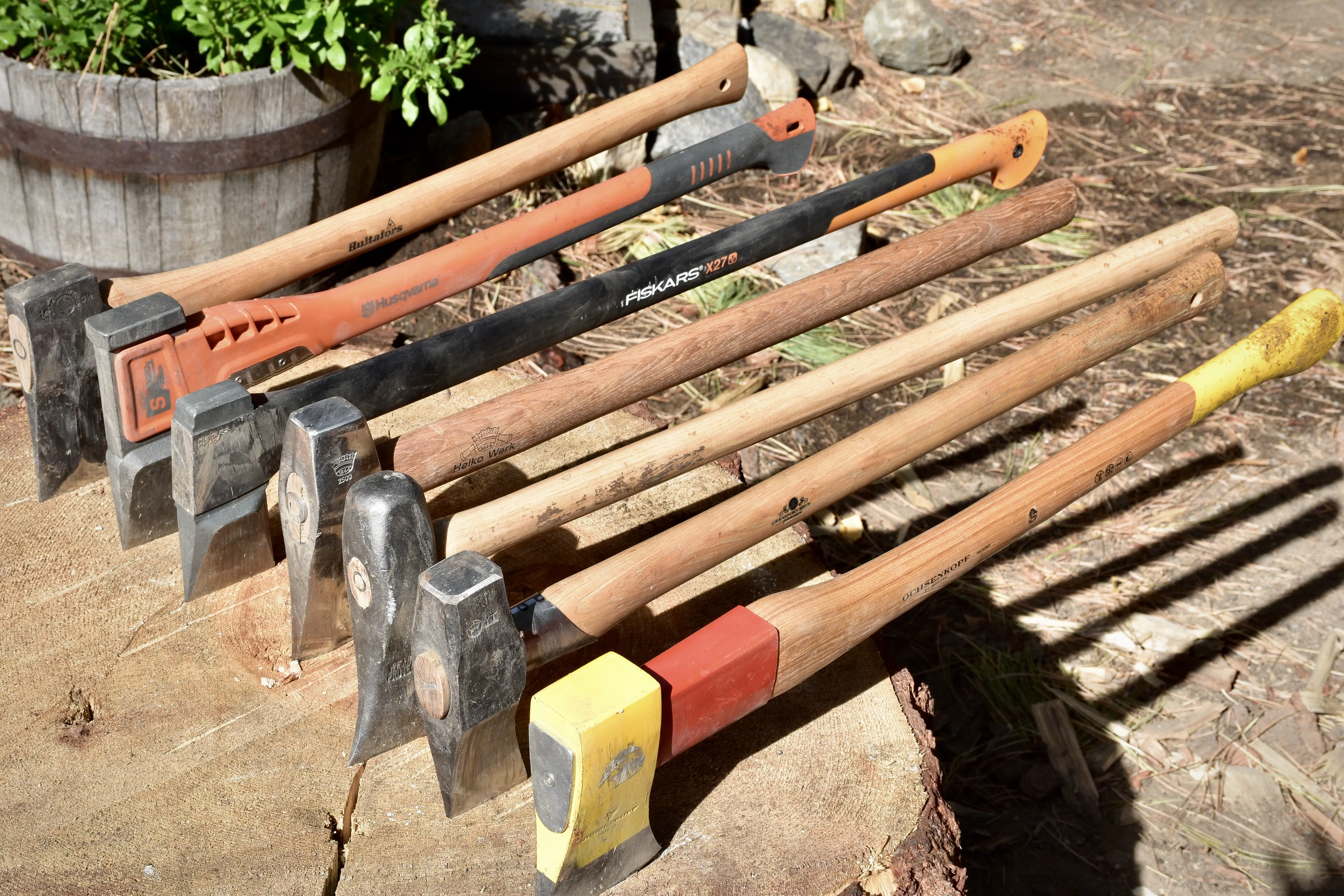
How We Tested the Best Axes for Splitting Wood
We tested the best axes for splitting wood in the most sensible way possible: by buying a variety of axes and splitting a lot of wood! We started by researching the best axes on the market created by some of the most legendary steel forgers on the planet. We eventually narrowed our list down to 11 models that we purchased and put to a side-by-side test.
After finally melting out from Lake Tahoe’s snowiest season on record in 2022-2023, lead tester Nick Bruckbauer had nearly two cords of fresh, locally cut pine and fir rounds delivered to his home. After moving and stacking them and preparing a work area, he got to work over the next several months, alternating among the nine different axes to split the stack of rounds into huge piles of firewood. The following fall, a next-door neighbor felled a 48-inch diameter pine, and Nick accepted an additional couple dozen rounds for further splitting and testing.
Before getting to work, we thoroughly examined each axe to get a sense of its craftsmanship and the quality of its materials. We inspected everything from head size and shape, to blade sharpness, to handle length, shape, and materials. We tested the quality and ease of use of the included sheaths, and read any documentation about the axe maker’s history.
There’s only one way to determine the true quality of an axe, and that’s to swing it and swing it hard! We ended up splitting over hundreds of rounds and logs that ranged in diameter from approximately 14 to 30 inches, as well as some larger half rounds that were over 40 inches in diameter. All told, we hand-split nearly four cords of wood during our testing.
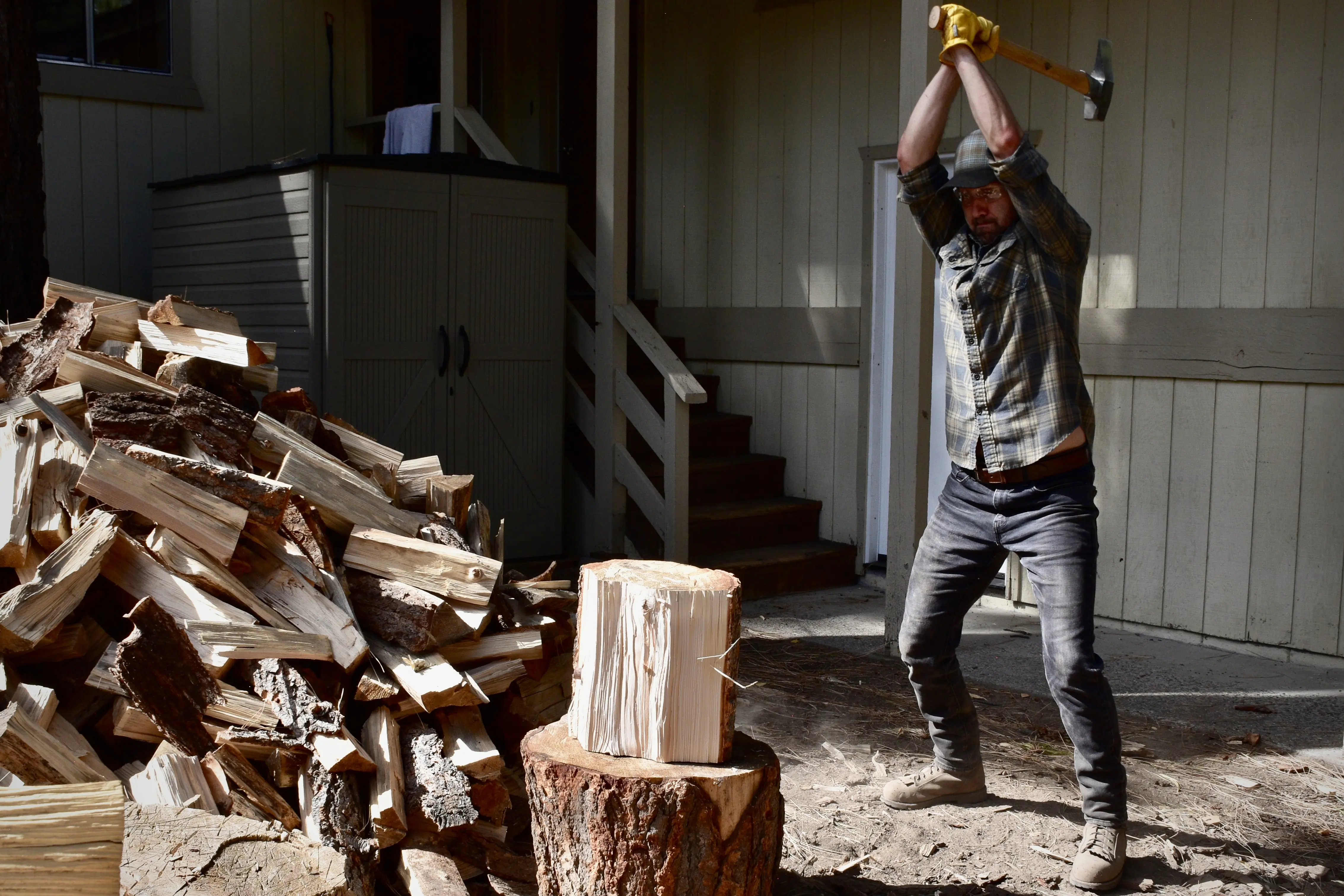



While pine and fir are definitely softer woods, they can be notoriously challenging to split, with some rounds having long, twisty grains, plenty of sap, and lots of knots that can stop even the toughest axe in its tracks. This local wood was the perfect testing ground to find the best axe for splitting wood. We ran into some difficult pieces that took extra effort to split, and it helped us identify the highest-performing axes to handle the toughest situations.
Nick Bruckbauer is a year-round Lake Tahoe resident, lifelong gear nerd, and proud DIYer who enjoys the satisfaction of completing “hard” and meaningful labor to help provide resources for his family. With continually rising fuel prices, regular winter power outages, and an ongoing supply of free, locally harvested logs, Nick welcomes the effort of hand-splitting this wood to help supplement his family’s home heating in a rustic and natural way.
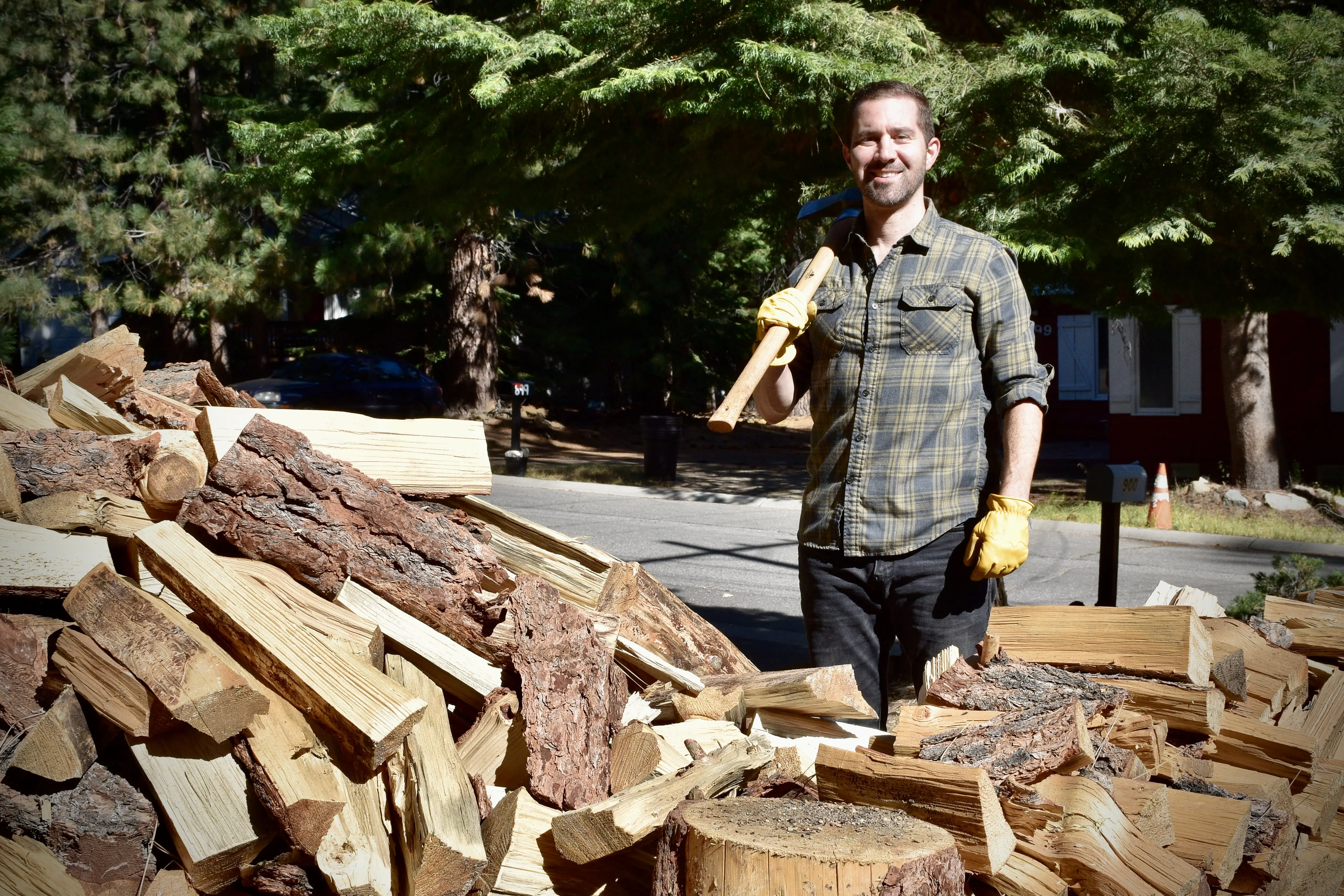



Buyer’s Guide: How to Choose the Best Axe for Splitting Wood
The best axe for splitting wood will generally depend on a few variables, including your body size and strength, your preferred handle length and material, and the size and type of wood that you’re splitting. From there, we’ll provide some universal design recommendations to look for based on our first-hand testing experience.
Types of Axes
There are a variety of axe designs, and not all of them are ideal for splitting wood. There are shorter handheld designs with thin, sharp blades that are ideal for trimming and cutting smaller pieces of wood, and there are larger sledgehammer styles with broader wedge-shaped blades that are ideal for splitting larger chunks of wood.
Hatchets
Hatchets are the smallest type of axe, and will typically weigh between 1 and 2.5 pounds and have handles that are approximately 12 to 18 inches long. They are a versatile tool for camping or around the house, as they can be used both for cutting smaller branches (up to a few inches in diameter) and for splitting smaller logs (up to approximately 8 or 10 inches in diameter).
Hatchets will typically have sharper blades that allow for precise cutting or trimming work, which makes them less versatile for splitting larger logs, since the narrower blade will have a tendency to get embedded in the wood.
The advantage of hatchets is that they are usually pretty lightweight, can be carried with you while hiking or camping, and provide excellent versatility for a variety of tasks. While they provide plenty of utility, we did not include them in this review because they are too small and light for heavy-duty splitting work. If you’re more interested in a hatchet than a splitting axe, check out our Buyer’s Guide of the Best Camping Hatchets.
Cutting Axes
The next step up from a hatchet is a cutting axe. Sometimes referred to as a forester axe or a woodworker axe, these tools will often look similar to a hatchet, just bigger. They will typically weigh between 3 and 5.5 pounds and have handles that are approximately 20 to 30 inches long.
Cutting axes have a sharp, narrow blade with a long cutting edge, and are designed to cut against the grain of the wood for tasks such as trimming branches or felling trees. While some designs will have some versatility to also split wood, they are usually a poor choice for splitting wood, since the long, sharp blade will easily become embedded in the wood.
Because of this, we did not include any cutting axes in this review. Cutting axes will also typically have curved, ergonomic handle shapes for leverage and control during repeated cutting tasks.
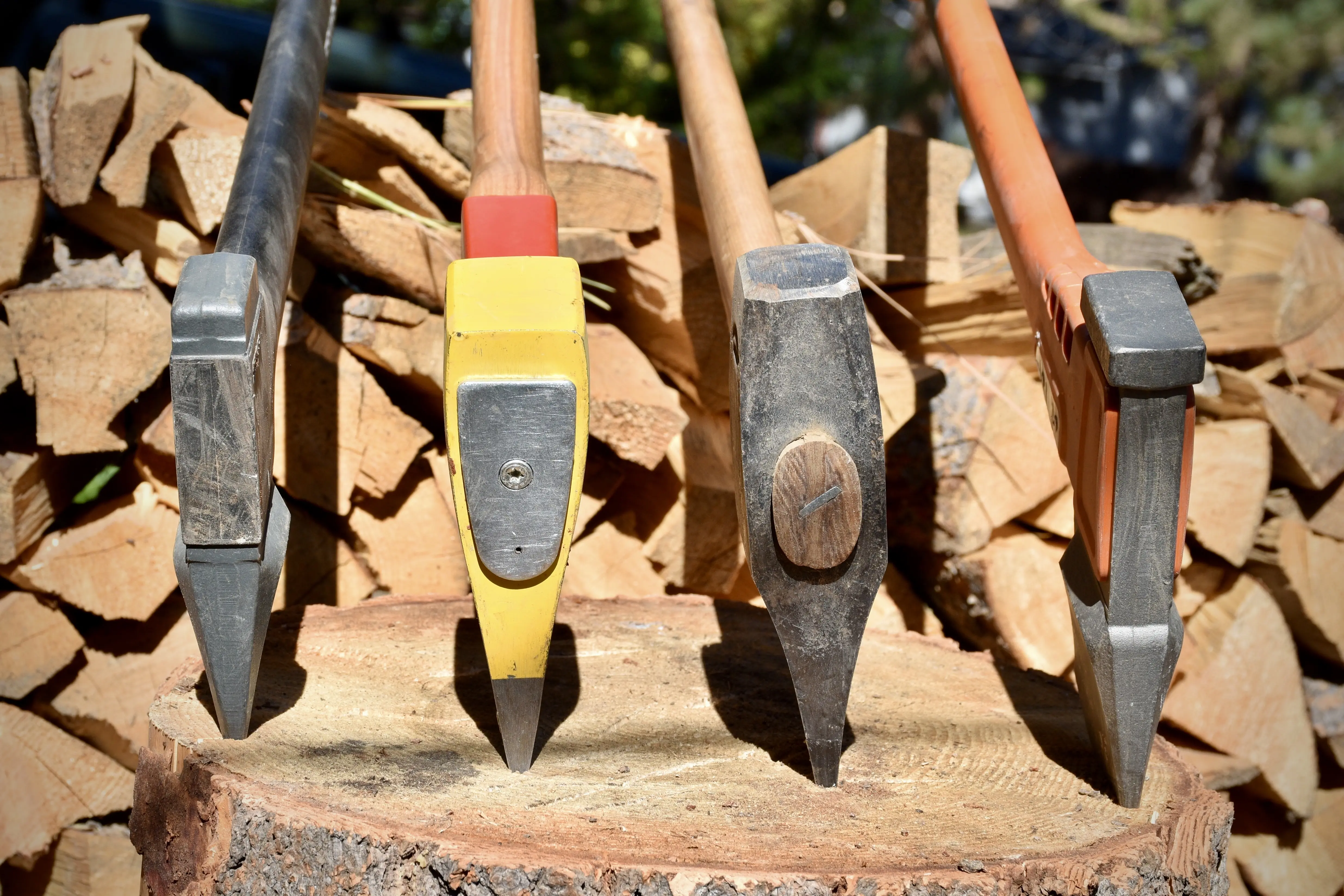



Splitting Axes
Splitting axes, sometimes interchangeably referred to as splitting mauls (more on that below), are specifically designed for splitting wood — or pushing it apart along the grain — rather than cutting against the grain. As such, splitting axes and mauls will typically be heavier, weighing anywhere from 3.5 to 8 pounds, and have a longer handle that is 28 to 36 inches long. They will also have broader, wedge-shaped heads that don’t need to be as sharp as cutting axes.
The ideal splitting axe will have a blade that is able to penetrate into the wood and push it apart without getting completely embedded and an overall weight and length that are comfortable for the user. The most effective splitting axes will typically be a bit heavier, providing the heft to help the axe power through tough pieces of wood.
However, heavier isn’t always better, as a lighter axe is easier to control, easier to swing at a faster speed, and will generally cause less fatigue throughout a splitting session.
Splitting Axes vs. Splitting Mauls
The terms splitting axe and splitting maul sometimes get used interchangeably, so you might be wondering what the difference is, if there even is a difference. Many people often refer to any large, heavy splitting axe as a maul, but that’s not necessarily the case.
The key differentiator is that the head of a splitting maul can also be used as a sledgehammer for pounding stakes or striking poles. The head of a splitting maul will have the splitting blade edge on one end, and a hammer-shaped face on the other end. Unless a tool is specifically designated as a maul, it should not be used for any purpose other than splitting wood.
Though it’s not always the case, splitting mauls also tend to be bigger and heavier than splitting axes. Splitting axes generally are 20 to 30 inches long and weigh anywhere from 3.5 to 6 pounds, while splitting mauls are generally 30 to 36 inches long and weigh 6 to 8+ pounds. Both will have wider, wedge-shaped blades designed to push wood apart along the grain, rather than cutting wood against the grain.
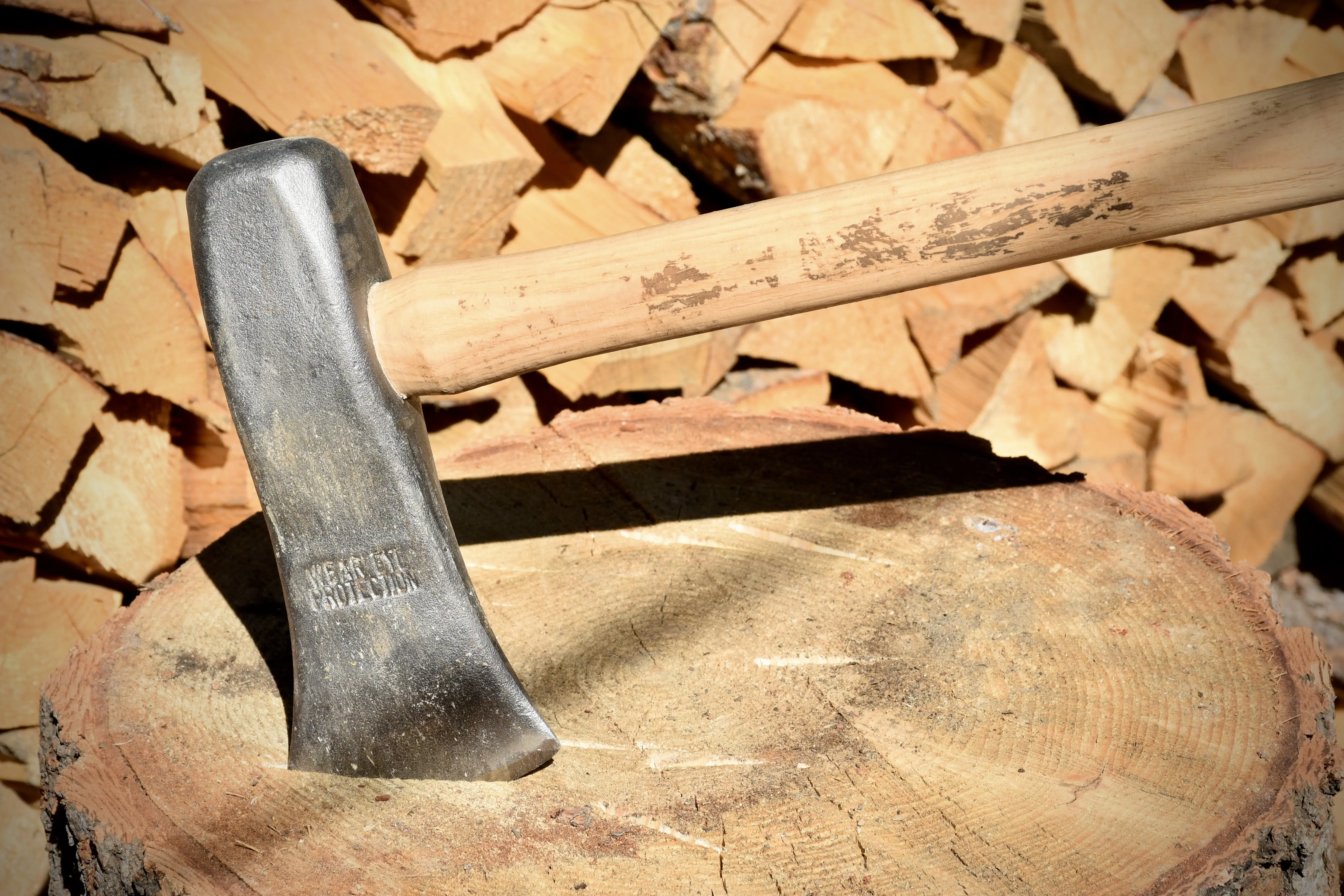



In our test lineup, three products are classified as mauls, the Gransfors Bruk Splitting Maul, the Council Tool 6-lb Sledge-Eye Maul, and the Estwing Fireside Friend Splitting Tool.
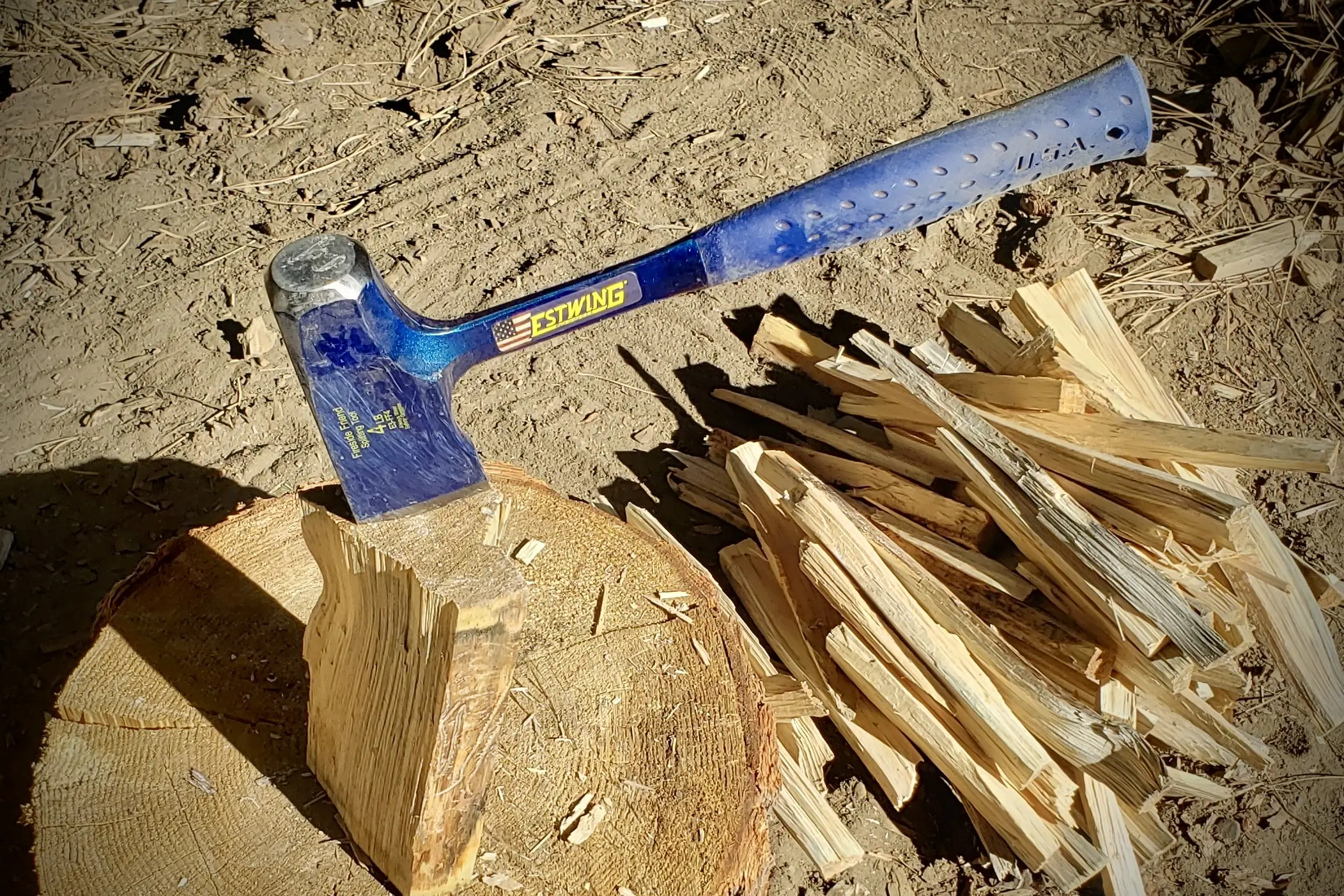



Head Weight and Overall Weight
While an axe’s head weight and overall weight will have a big impact on its performance, this metric also comes down quite a bit to personal preference. A heavier axe might be better suited for larger users with bigger and stronger hands, while a lighter axe may be better suited for smaller users or those with smaller hands. Both heavier and lighter axes can get the job done with the right technique and effort.
Here’s where it gets more interesting. For any physics enthusiasts out there, remember that force = mass x acceleration. This means that when a heavier axe provides a certain amount of force at a certain swing speed, a lighter axe will be able to match that same amount of force — it will just require a faster swing speed.
Of course, this is a fairly broad generalization, but this is where personal preference becomes important. It’s important to find an axe size and weight that matches your body type and your swing speed preferences.
A heavier axe will generally be more difficult to swing and will likely cause increased fatigue over repeated swinging, but will also provide more splitting force at a lower overall swing speed. A lighter axe will be easier to swing and will likely cause less fatigue over repeated swinging, but will generally provide less splitting force than a heavier axe (assuming the same swing speed). A lighter axe will be easier to swing faster, and will also be easier to control for more precise swings.
Our lead tester, Nick Bruckbauer, is 5’11” tall, weighs 175 pounds, and has average-sized hands (men’s Medium glove size). He strongly prefers the size and weight of the Gransfors Bruk Splitting Maul. With a 5.5-pound head weight and 7.2-pound overall weight, this tool feels just right for most splitting tasks.
It has enough mass to power its way through thicker or tougher rounds but is just light enough (compared to 7.5 to 8-pound models) that it’s manageable to maintain control and a reasonable swing speed. It also feels nicely balanced so that fast, hard swings feel efficient and don’t cause undue fatigue.
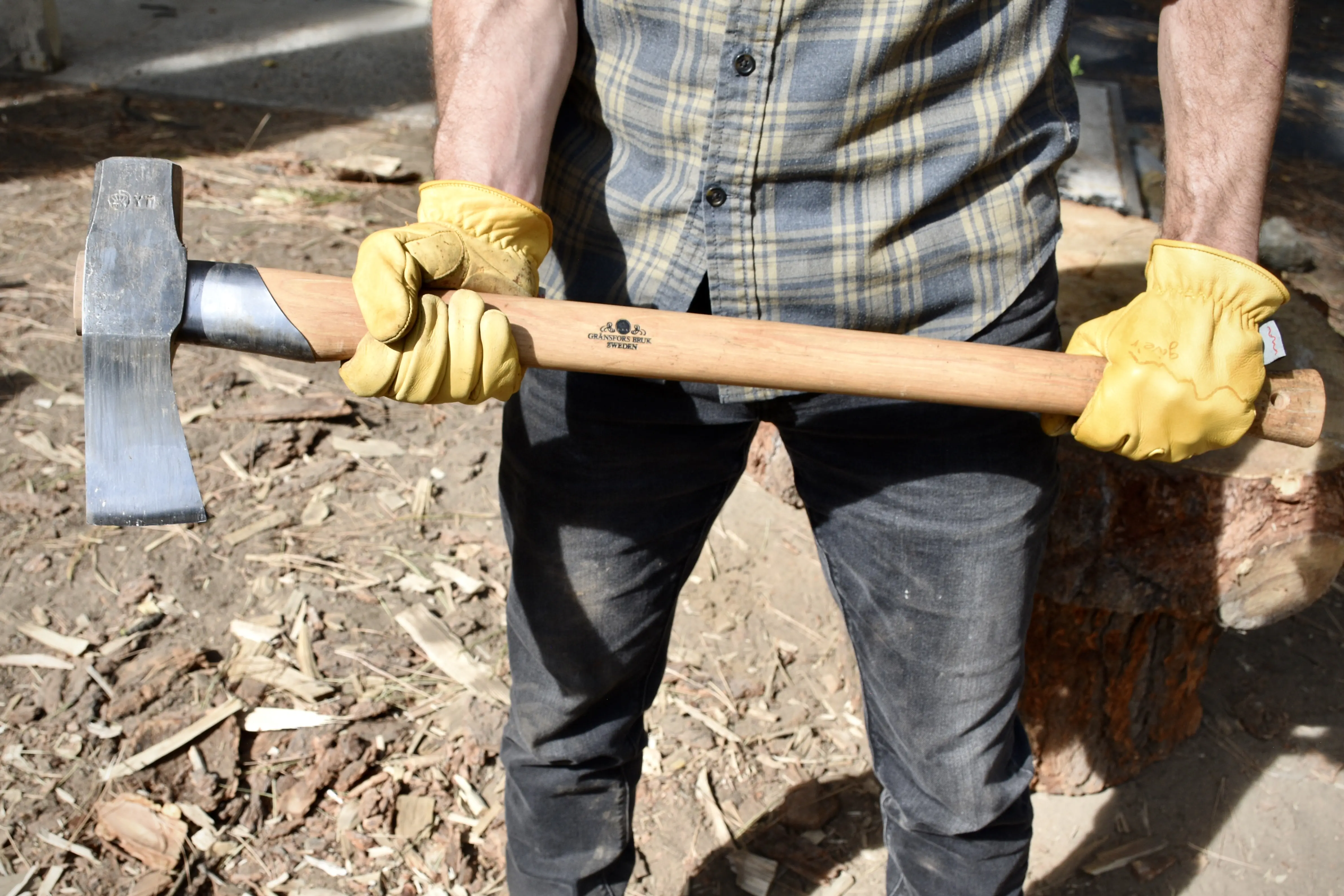



Head Size and Shape
The head size and shape are two of the primary design features that separate a splitting axe from a cutting axe (and a splitting axe from a splitting maul). While most splitting axes have a broader wedge-shaped head than most cutting axes, there is still a variety of shapes and sizes even among our test lineup of splitting axes.
On the narrower end, the Husqvarna Splitting Axe S2800 has a longer blade edge and a narrower blade width than most other splitting axes. This made it our go-to choice for splitting smaller rounds, or larger rounds once they’ve been split in halves or quarters.
The long blade edge gave us the confidence to strike the wood precisely where we wanted, and the narrow blade allowed it to power through smaller pieces of wood pretty easily. It did struggle a little with larger rounds, as the narrower blade had a tendency to get embedded in the wood.
On the broader end, the Gedore Ochsenkopf Spalt-Fix Axe has a heavy, large, wedge-shaped head. What this design lacks in finesse, it makes up for in brute force. The Ochsenkopf is our favorite axe for finishing off difficult logs or rounds. Its massive head powered through thick, knotty chunks that other axes struggled with.




The Gransfors Bruk Splitting Maul has the ideal head size and shape for splitting wood. It has a large, massive head that quickly narrows to a concave shape and a fairly narrow blade edge. This design allows the narrow blade to penetrate difficult pieces of wood, but then the concave shape helps prevent it from becoming embedded. Finally, the large, heavy head helps power through and finish pushing the wood apart.
The Fiskars X27 Super Splitting Axe also has a nice head shape that’s not too thick and not too thin, making it an efficient splitter that doesn’t get embedded in the wood too easily. We’re a big fan of the Fiskars, though its lighter overall weight made it a little less effective splitting larger rounds, compared to some heavier designs.
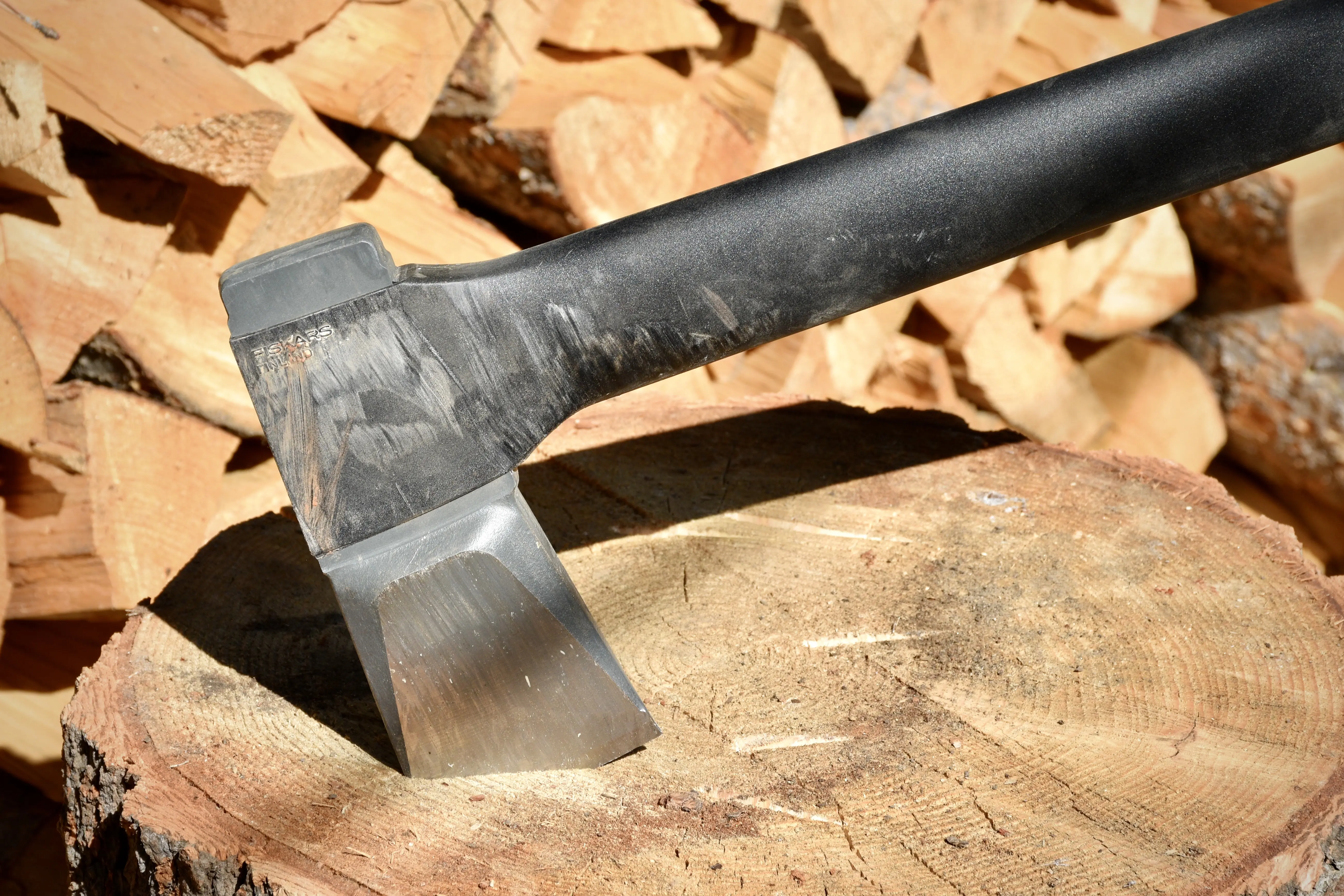



Finally, the Helko Werk Classic Nordic Splitting Axe and the Hultafors Hult Splitting Axe have unique Scandinavian wedge-shaped head designs. This distinctive shape has a long, rectangular shaped head that gradually narrows to a three-dimensional wedge-shaped blade.
This design is very efficient for splitting wood but is a little less versatile than other designs due to the shorter blade edge length that makes precise strikes a little more challenging.
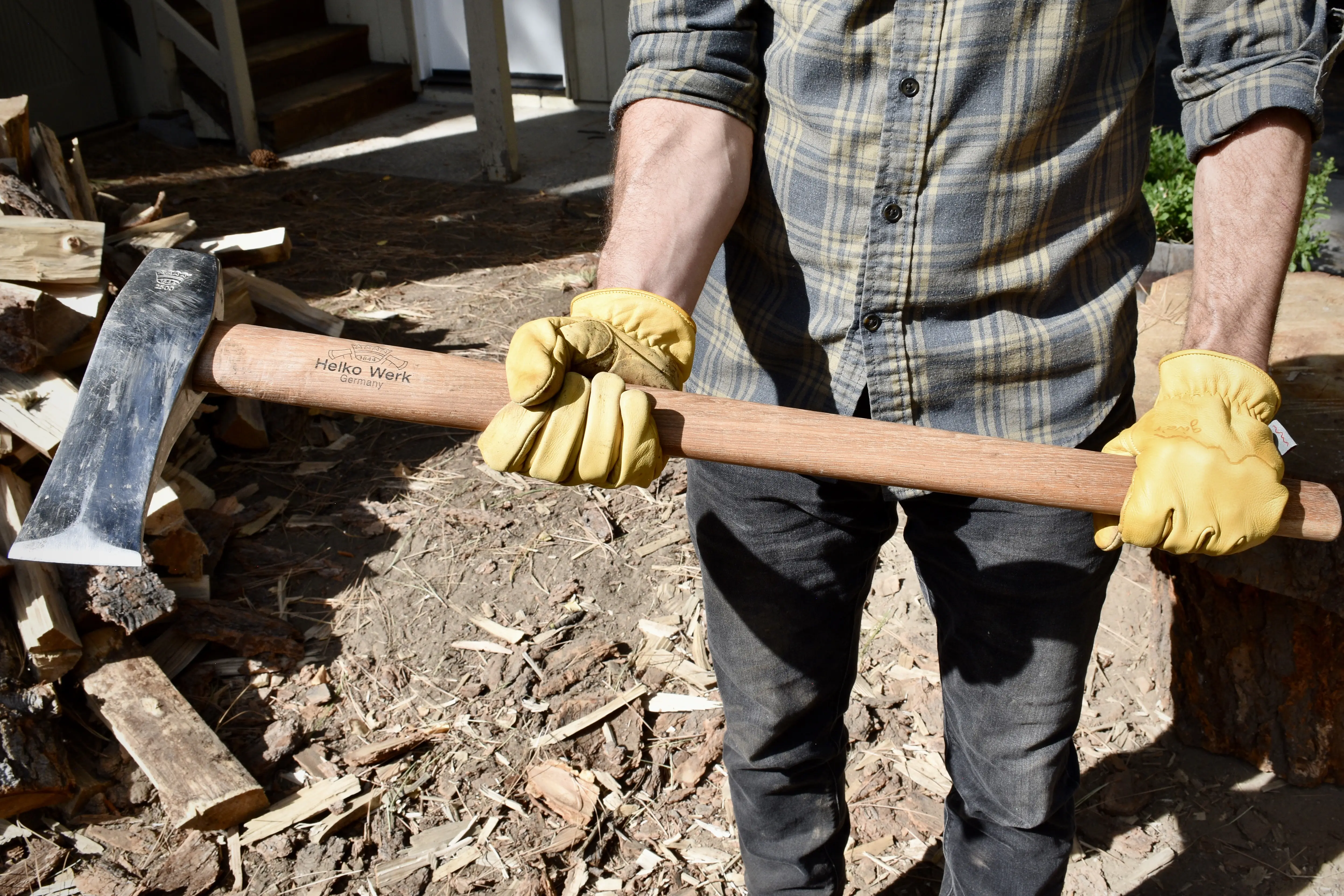



Handle Length
The handle length will typically come down to your height and your personal preferences.
A longer handle will allow you to stand further away from the wood (which could add a small element of safety) and could allow you to comfortably split wood that is on the ground rather than elevated on a chopping block. A longer handle also provides more leverage that can increase your swing speed, but can also make the axe a little more difficult to control for precise strikes.
A shorter handle will force you to stand closer to the wood, and will likely require elevating the wood on a chopping block to keep you in a comfortable body position. A shorter handle won’t generate as much swing speed as a longer handle, but will typically be easier to control for more precise work.




Our 5’11” lead tester found the 31.5-inch length of the Gransfors Bruk Splitting Maul to be ideal. Shorter lengths between 28 and 30 inches also felt more comfortable than the longer 36-inch lengths, but again, this can be dictated by personal preferences.
During our 2024 testing period, we introduced two shorter “one-handed” models to our test lineup, the Hults Bruk Agdor 20 and the Fiskars Norden N12. These axes are 20 inches and 19 inches in length, respectively, making them ideal for both one- and two-handed splitting. We enjoyed grabbing one of these to finish off some smaller logs into kindling, after hucking around bigger and heavier axes all day.
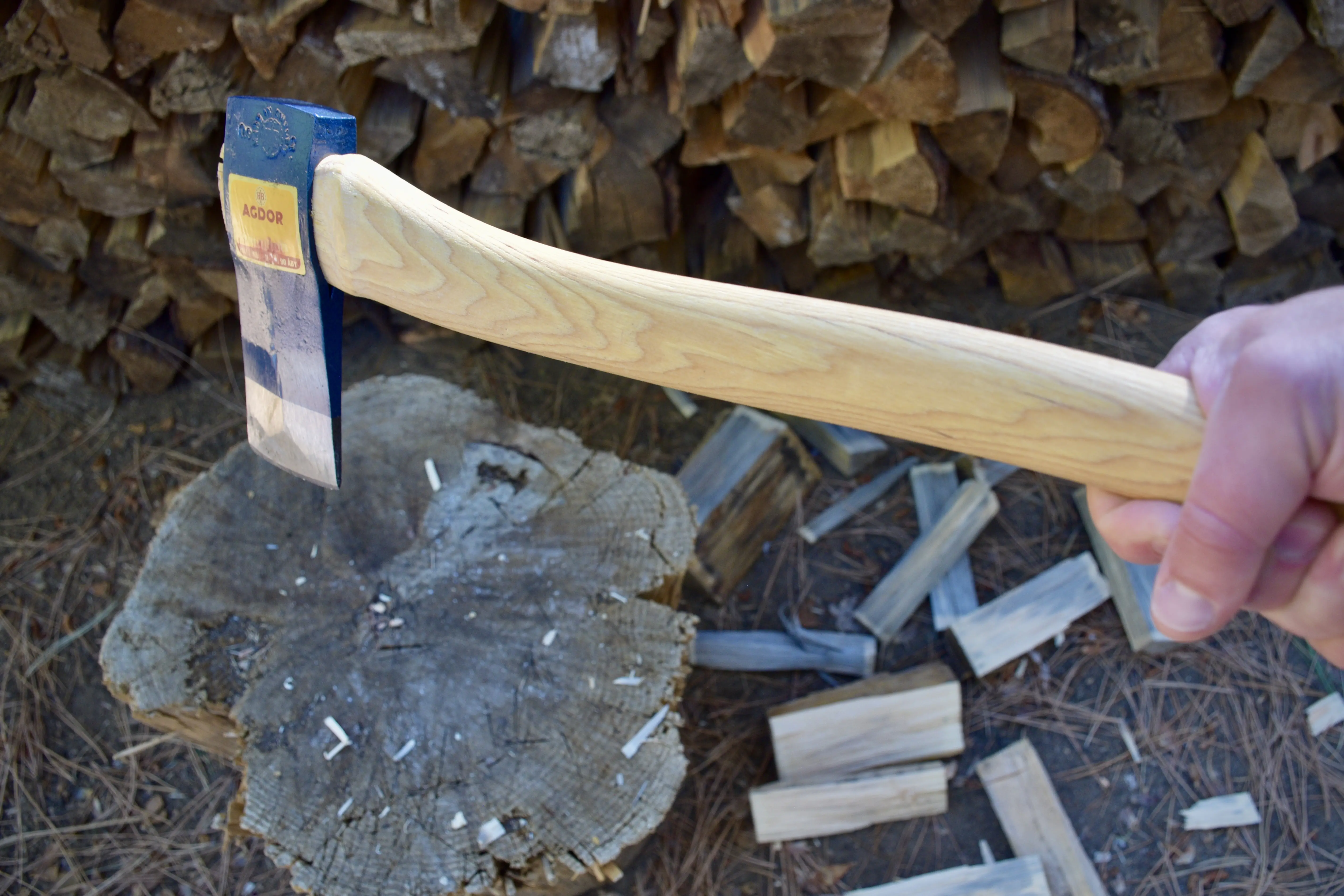



Handle Material
Splitting axe handles are made from composite materials or from wood materials, typically American hickory.
American hickory wood is the traditional axe handle material because it is a heavy and dense wood and has a straight grain pattern. Both of these features help make hickory strong and shock-resistant, both critical features for a high-impact tool.
The advantages to wood handles are that they can be replaced if they crack or split, and the handle can be trimmed or sanded to be reshaped by the user. The disadvantages to wood handles are that they are often heavier than composite materials, and they can split or crack if used improperly.




Composite materials are generally lighter than wood and still have good impact resistance. Composite handles cannot be replaced if they break, but they are typically very strong, so this is not a huge concern.
The choice between wood or composite materials really comes down to personal preference, as handle materials won’t have much, if any, impact on the overall splitting performance. Wood handles look and feel more traditional, while composite handles look and feel more modern.
We’re definitely big fans of the classic look of a traditional splitting axe with a wood handle and a hand-forged steel head, but we also really liked the feel and performance of the Fiskars X27 Super Splitting Axe and the Husqvarna Splitting Axe S2800, both more modern designs with composite handles.
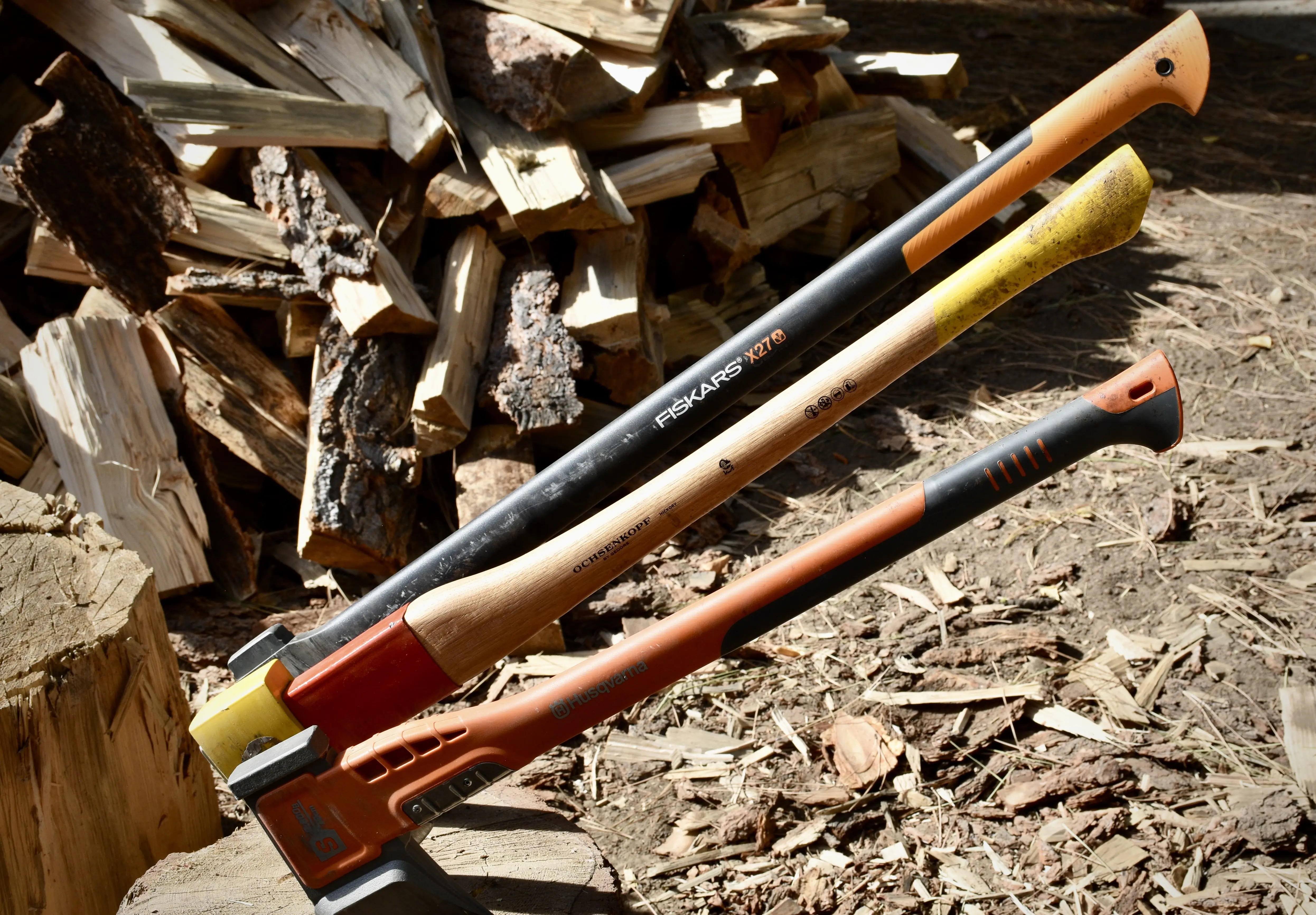



Recommended Safety Equipment
Swinging around a heavy, sharp steel tool can obviously be dangerous, so we also want to include some recommended safety equipment and some safety considerations.
The first, and most critical piece of safety equipment is eye protection. This should be non-negotiable. Splitting wood will inevitably send shards of wood flying in every direction, and you’re putting your face pretty close to the impact zone and line of fire. We used a simple pair of DeWalt safety glasses that did the trick.
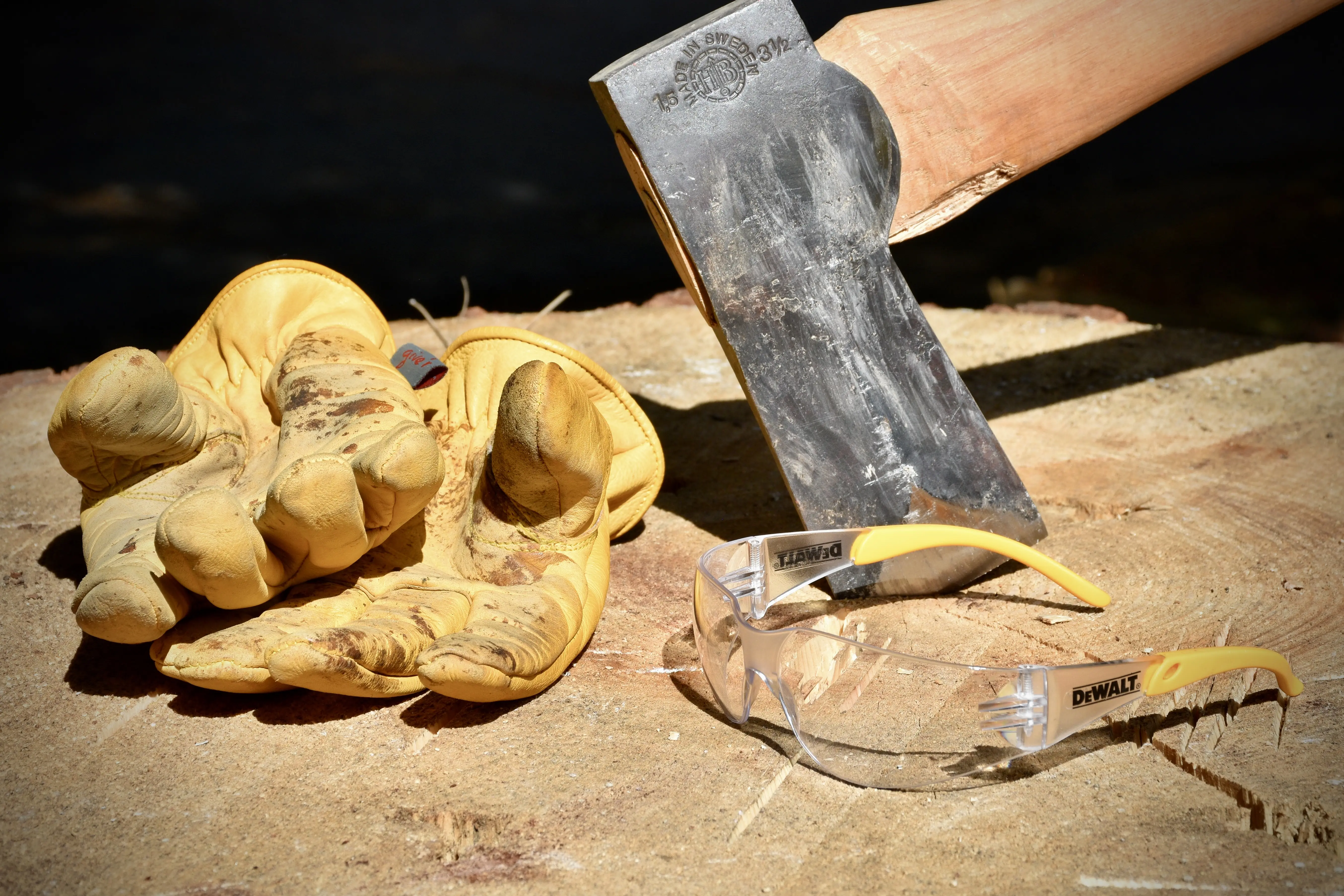



Next, we also highly recommend a good pair of work gloves. Splitting wood includes hauling and moving wood rounds and split logs, and repeatedly grabbing and swinging an axe over and over. Work gloves will help protect you from simple nuisances like blisters, and from more severe injuries like cuts or scrapes.
We used and enjoyed the Give’r Lightweight Gloves throughout our whole testing period. These leather gloves fit well, are not too thick and not too thin, and come at a reasonable price.
If you’re doing repeated splitting, we also recommend a good pair of steel-toed work boots. While this isn’t necessarily mandatory, keep in mind that you’ll likely be moving heavy wood rounds and logs that can weigh 60-80 pounds or more, and pinching your piggies under one of those won’t feel so good. Proper foot protection can also protect you from an errant swing of an axe.
This may sound silly, but when you’re fatigued, and when you’re splitting some gnarly, knotty wood, an axe can easily bounce off the wood into your feet or body. We have a small slice in our steel-toed boots to prove it.




Finally, we recommend taking a little extra time to make sure you prepare your work area. This means having a flat, level open surface away from houses, cars, trees, or other equipment, with plenty of space to freely swing your axe. You’ll also make sure you have plenty of space to stage your pre-split wood and to pile or stack your split logs. Your work area can clutter up quickly, and it’s important to maintain a clear work area.
Price & Value
Budget
We’d consider any splitting axe less than $70 or so to be a budget axe. These tools will typically be mass-produced, widely available, and have simple designs. They would be suitable for occaisional use, but won’t have the same type of performance or longevity as more expensive options.
The standout in this range is our best value pick, the Fiskars X27 Super Splitting Axe ($70), which is part of the high-performing and wallet-friendly Fiskars X Series of axes. If you’re new to wood splitting, you can’t go wrong with this series of axes. They have lightweight and comfortable handles and efficient blade shapes, making them easy to use for beginners and veterans alike. The only drawback is that the handles can’t be replaced if broken, and the steel isn’t as high-quality as other hand-forged axe heads.
Besides the Fiskars X27, the other axes we tested from this price range were a little underwhelming. The Council Tool 6-lb Sledge-Eye Maul ($59) is a pretty standard hardware store tool. It gets the job done, but has a lower-quality fit and finish, and the balance and ergonomics don’t compare to higher-end tools. If you split wood regularly, or want a tool that could potentially last your lifetime, we’d recommend spending a little more.
Mid-Tier
Ranging from about $70 to $150 in price, a mid-tier axe will typically get you a little nicer materials and a more distinct design. A few examples from this range include the Husqvarna Splitting Axe 2800 ($100) and the Gedore Ochsenkopf Spalt-Fix Axe ($130). The Husqvarna has a composite handle with a thin blade with a long edge, making it ideal for more precise strikes. The Ochsenkopf is a beast of an axe with a heavy-duty head, a hickory wood handle, and very good construction quality.
Axes in this range are high-quality, very capable tools that should perform well and last a long time. The only advantage to spending more on a premium model is that premium models will typically have hand-forged heads, and more unique shapes that help optimize comfort and swing ergonomics.
This range also sees a pair of smaller, one-handed axes, the Hults Bruk Agdor 20 ($134) and the Fiskars Norden N12 ($120). Both of these models have similar materials and construction quality as their more premium counterparts, but in a smaller version (20 inches and 19 inches, respectively).
Premium
Starting at about $180 and up, premium splitting axes have the highest-end materials and construction. Most axes in this range are hand-forged by legacy companies that have been around since the 1600s. Our top overall pick, the Gransfors Bruk Splitting Maul ($255) has a premium feel and ergonomics, and is a beautiful work of art that could hang on the wall next to your fireplace. We also really like the Helko Werk Traditional Spaltaxt ($180). Both of these axes just feel high-end. Everything from the materials, to the feel in your hands, to the construction fit and finish is top-notch.
A more expensive axe doesn’t necessarily do a better job of splitting wood, but the more refined feel and balance will help you operate more efficiently during your work. This means that you’ll save energy and be less likely to hurt yourself or damage your equipment. The steel used on premium models is typically of better quality, meaning that the axe head will likely outlive you if properly cared for!
Frequently Asked Questions
Many splitting axes and cutting axes may look similar at first, but their designs and performance features have distinct differences. A splitting axe is designed to split wood by pushing it apart along the grain, while a cutting axe is designed to cut wood by slicing into it against the grain.
A splitting axe will typically be heavier than a cutting axe, and will have a broader, wedge-shaped head with a shorter blade edge. A cutting axe will typically have a thinner head with a longer cutting edge and a much sharper blade.
Most splitting axes and splitting mauls look and perform similarly, but the main difference is that the head of a splitting maul has a hammer-shaped face on the opposite end of the blade, and can be used as a sledgehammer to drive stakes, pound poles, or strike a splitting wedge.
Splitting axes without this hammer-shaped face should not be used to strike anything besides splitting wood. Splitting mauls will generally also be bigger and heavier than splitting axes, but that isn’t always the case.
Composite axe handles look and feel a little different than wooden handles, and are typically lighter than wooden handles, but the overall performance between the two is mostly similar. The choice comes down to personal preference.
Wooden handles are typically made from American hickory wood, which is known for its straight grain pattern and impact-resistant qualities. A wooden axe has a more traditional look and feel, and allows the user to replace the handle if needed, or reshape it to their exact liking.
Composite handles are typically lighter weight, and similarly impact-resistant, but cannot be replaced if they were to break. Composite handles also have a more modern, high-tech aesthetic.
A heavier splitting axe isn’t necessarily better than a lighter one. There are advantages and disadvantages to each design, and a lot of the decision comes down to user size and personal preference. A heavier axe will provide a relatively greater splitting force to the wood, but the heavier weight will make it more difficult to swing and control than a lighter axe.
A lighter axe will provide a relatively lesser splitting force to the wood but can be swung at a faster speed and with more control and precision. Bigger and stronger individuals with larger hands will feel more in control of a heavier axe, while smaller individuals may have an easier time swinging a lighter axe.

